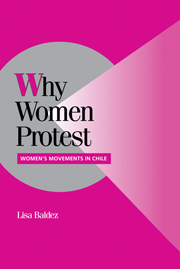Book contents
- Frontmatter
- Contents
- List of Figures and Tables
- Preface
- 1 WHY WOMEN PROTEST: TIPPING, TIMING, AND FRAMING
- 2 MOTHERS OF THE COLD WAR, DAUGHTERS OF THE REVOLUTION: A HISTORICAL OVERVIEW OF WOMEN AND CHILEAN POLITICS
- Part One Women Against Allende
- Part Two Women Against Pinochet
- 6 GENDERED NETWORKS AND THE REBIRTH OF CIVIL SOCIETY
- 7 WOMEN DEFEND LIFE: MASS PROTESTS AND THE WOMEN'S MOVEMENT
- 8 DEMOCRACY IN THE COUNTRY AND IN THE HOME: WOMEN FOR AND AGAINST DEMOCRATIC TRANSITION
- 9 WHY WOMEN PROTEST: COMPARATIVE EVIDENCE
- References
- Index
6 - GENDERED NETWORKS AND THE REBIRTH OF CIVIL SOCIETY
Published online by Cambridge University Press: 06 July 2010
- Frontmatter
- Contents
- List of Figures and Tables
- Preface
- 1 WHY WOMEN PROTEST: TIPPING, TIMING, AND FRAMING
- 2 MOTHERS OF THE COLD WAR, DAUGHTERS OF THE REVOLUTION: A HISTORICAL OVERVIEW OF WOMEN AND CHILEAN POLITICS
- Part One Women Against Allende
- Part Two Women Against Pinochet
- 6 GENDERED NETWORKS AND THE REBIRTH OF CIVIL SOCIETY
- 7 WOMEN DEFEND LIFE: MASS PROTESTS AND THE WOMEN'S MOVEMENT
- 8 DEMOCRACY IN THE COUNTRY AND IN THE HOME: WOMEN FOR AND AGAINST DEMOCRATIC TRANSITION
- 9 WHY WOMEN PROTEST: COMPARATIVE EVIDENCE
- References
- Index
Summary
Many Chileans welcomed the coup as a temporary means of reestablishing order. Yet it soon became clear that General Pinochet intended to alter the structure of Chilean politics and society in fundamental ways. The government shut down democratic institutions in order to weaken the influence of political parties, which had long been considered the “vertebral column” of civil society (Valenzuela and Valenzuela 1986; Garretón 1989). The military systematically annihilated the leaders of the Left through disappearance, torture, and murder. The figures are grim: “Within six months [the military] had arrested 80,000 persons, and 160,000 suffered politically motivated job dismissals. An estimated 200,000 persons, including political refugees and their family members, went into exile” (Roberts 1998: 94). José Tohá, the cabinet minister impeached in the wake of the March of the Empty Pots, was sent to a concentration camp on Dawson Island, an isolated spot in the south of Chile. He died there a year later (Bitar 1987). Hernán del Canto, the minister identified as saying “we love women very much” in Chapter Four, went into exile in Colombia and then East Germany after soldiers robbed his house. He did not return to Chile until 1988 (Hite 2000: 113). Carlos Prats, the former Commander-in-Chief of the Army, fled to Buenos Aires with his wife. Both were killed outside their apartment by an assassin in September 1974. The regime expelled some 30,000 students and replaced several thousand university faculty members with military personnel. It restructured the economy to reduce the role of the state, cutting social service budgets severely.
- Type
- Chapter
- Information
- Why Women ProtestWomen's Movements in Chile, pp. 125 - 145Publisher: Cambridge University PressPrint publication year: 2002



